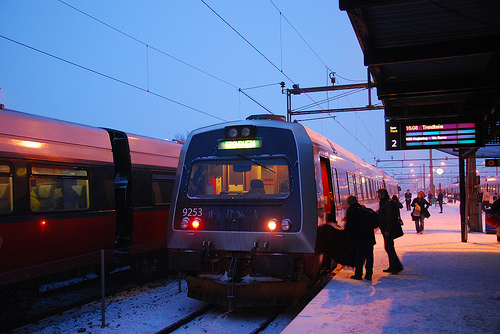All too often first time travelers to Europe are under the impression that a Eurail pass is the best option. Sometimes this is true but very often it’s not. Then, even if you know you need a pass, trying to figure out which is the best value for your plans can be confusing.
Vagabondish is reader-supported. When you buy through links on our site, we may earn a small affiliate commission. Read our disclosure.
In the following guide, we’ll discuss how to sort out all of the variables to consider when choosing a pass. We’ve also put together some handy worksheets that will make getting the most for your money much easier. If you’re anything like me, you’d much prefer to spend your money enjoying a Hefeweizen at a German Biergarten or touring a famous French castle than wasting it on rail pass days you’ll never use.
Take note that we’re only discussing train travel here. Flying or driving from destination to destination is always another option.

Transylvanian Mountains, from a Train © wili_hybrid
Know How You Trip
Be honest with yourself (and your travel companions) about the type of trip you’re taking and what you want to see. Will you be traveling for days, weeks or months? Are you hanging out in one country or planning to see several? How many cities in each country will you visit? Do you even know which cites these are yet or are you going to travel based on what that Swedish girl at your hostel recommended? Knowing answers to these questions can really narrow your options.
You can use this printable worksheet to organize all of this info.
Options, Options Everywhere
Rail passes are sold in a few distinct forms. There are those that cover a certain number (5, 6, 8, 10, 15) of “travel days” within two months known as Eurail Select Passes. These are broken down even further depending on if you want to visit 3, 4 or 5 bordering countries. (By now you’re starting to understand why its important to think about the type of trip your taking.)
Another option, known as the Eurail Global Pass also comes in two varieties: consecutive and flexi. The consecutive Global Pass gives you unlimited travel on the entire rail network (Austria, Belgium, Croatia, Czech Republic, Denmark, Finland, France, Germany, Greece, Holland, Hungary, Italy, Luxembourg, Norway, Portugal, Republic of Ireland, Romania, Slovenia, Spain, Sweden, and Switzerland) within 15 days, 21 days, 1, 2 or 3 months. The flexi variety gives you 10 or 15 “travel days” on the entire network within two months.
If your only planning to visit one small region (typically two countries that border each other), there may be another option to suit your needs. Some countries like Germany and the Czech Republic, France and Italy as well as Denmark and Sweden (among others; there are 25 total) offer a form of the Eurail Select Pass that covers travel in only two countries (or a “region”). These passes will give you a certain number of “travel days” within 2 months to explore the area.
Of course if you are just planning to visit one Country there’s a pass for that too. These tend to vary by country but in general they work much like the Select pass with a certain number of “travel days” within a certain period of time.
Last but not least (since it can often be the cheapest way to go) there is no pass at all! You can always just purchase your tickets from one destination to another. These are typically referred to as point-to-point tickets and we’ll discuss them a bit farther down. Using the Point-to-Point chart we’ve designed, which gives a general idea of the costs and duration of most major train trips in Europe, is essential to deciding if a pass is worth it.
What Is A Travel Day?
Now you might be asking what is this “travel day” that has been mentioned over and over? This is not how many days you will be overseas. “Travel days” are those specific days that you are traveling between cities while in Europe. One “day” is travel anytime between 12 midnight on one night and 12 midnight on the next night.
Let’s say you leave Berlin, Germany at 8am on August 28th and Arriving in Prague, Czech Republic at 1pm the same day.
By writing down the arrival time on your pass (this must be done before the train attendant asks for it or you’re in trouble) you have used one travel day.
Of course if you are only stopping in Prague to pick up some cash from that rich Czech Aunt you’ve never met and are leaving two hours later to arrive in Munich by 9pm you’re still using just “one day”. But as soon as midnight rolls around your day is over. (No worries though – there’s tons to do in Prague after midnight.)
Will traveling on a night train cost me two “travel days” then? Maybe! There is a way around this though. If your night train leaves after 7pm then you only use one “travel day” by writing in your arrival time for the next morning. Essentially this gets you 5 extra hours of travel. Keep in mind however that this rule does not apply to the 7pm the day before your pass is validated. If your pass starts on April 20th, that means 12am April 20th.

Boarding the Train in Hamar, Norway © KOKONIS
Point-To-Point Tickets vs. Rail Passes
Now I’ve taken trips where I was so happy to have a pass and I’ve taken trips where I wasted gobs of money on having one. I’d say that about 10-15 percent of people could save money by relying on purchasing tickets as they go vs. buying a pass before hand.
The simplest way to get an idea if this option is better for you is to use the chart and worksheet we’ve put together. By filling out the worksheet you can narrow down which types of passes you should consider. Then by plotting a logical itinerary by connecting the cities you plan on visiting (using our point-to-point chart) and adding up the prices you’ll get a fairly good idea of which is going to save you money.
Deciding which is going to save you headache is really a personal decision but there are a few things to consider. First off, do not assume that just because you have a pass that you can hop on any train and be whisked away without worrying about dealing with ticket windows and reservations. True, you will have to do this every time if you go the point-to-point route; but more and more train trips are requiring that you make a seat reservation, pass or not, which can cost between 5-35 bucks.
This not only means dealing with ticket windows and lines (or ticket machines which, although generally easier, have several times eaten my money or ticket and resulted in a much longer wait) but also paying an additional fee beyond what you paid for the pass.
Night trains, high-speed and those trips that go from major destination to major destination at peak times are typically going to require a reservation and a ticket. Think of it this way; your pass is your ticket, your reservation is extra. My experience has taught me that avoiding reservations in Italy (and typically their trains are pretty crappy) is almost impossible. But, by taking the slower trains in Germany you can hop right on many trains with just your pass.
All that said, having a pass will eliminate some headaches and will cost you more than the pass itself when all is said and done. When figuring out your pass vs. point-to-point costs add about an average of $10-15 per “travel day” on top of the pass price to account for reservations.
Another assumption that many travelers make is that the rail pass gives them more freedom to alter their trip as plans change. Well, yes and no. Yes, by all means if the next leg of your journey requires no reservation then you can hop on any train out when you’ve seen all there is to see in Boeblingen, Germany (this takes about 20 minutes).
No, if there is any reservation required since you will have locked in the train you want when you made the reservation. Almost invariably there are no refund or exchange clauses on each reservation you make. Personally, without a pass, I buy my ticket out of which ever city I’m in the day I arrive or at least two days before I leave. Since more and more often a reservation is also required, my flexibility is the same either way.
All things being equal, it’ll ultimately come down to cost. Can you save a considerable amount of money purchasing your tickets once you arrive versus buying a rail pass before you head off to Europe (you cannot buy a Eurail pass in Europe)? Take the time to crunch the numbers and see what will work best for you and the goals of your trip.

Maschen Train Yard, Germany © mawel
A Few More Things To Factor In
We’ve already discussed reservation fees and freedom to change your mind but there are a few things – good and bad – to consider when deciding between rail passes and point-to-point tickets.
Coverage
While a Global Eurail pass does cover 95% of the rail network (and roughly each single country pass can be said to cover the same percentage within that particular country) there are some routes it does not cover. These are often referred to as scenic routes. A great example of this would be the train from Interlaken, Switzerland up the Jungfrau Mountain to the glacier caves at its peak.
Additional Discounts
That said, a rail pass does come with some great discounts if you know where to look. The scenic route mentioned above can be taken with a 25% discount for any Swiss rail pass holder (although you’re still going to have to pay upwards of 80 euro for the trip). In Germany you can ride any S-bahn train for free and this can save you tons of change when trying to get around Berlin (even out to Sachsenhausen Concentration Camp).
Beyond this you can also score discounts on everything from hotels to walking tours just by having a valid Eurail pass. Granted, most of them, you’ll never think of using or they don’t amount to all that much but they’re still worth checking out.
Age
Another aspect of rail passes to consider is how old (or young) you are. Those under 26 can purchase a youth pass at a cheaper price because it covers only 2nd class travel. Anyone 26 and older on their first day of travel must purchase a 1st class ticket at a significant increase.
A couple things come into play here. First, if anyone in your party is over 26 you’re going to have to all purchase the 1st class pass if you want to sit together during your trip. Let’s face it: at least at the beginning of a trip, you probably do.
Second, despite having a first class ticket, you are not guaranteed a first class seat. On top of that, many trains (in Italy for example; can you tell I’m a bit jaded by Italy’s train system?) have no differentiation between first and second class beyond a scotch taped piece of paper with a “1” or a “2” written on it slapped into a window.
Special Fares
Then there’s saving money with point-to-point tickets. Quite often with a little savvy you can find some great deals when purchasing your ticket at the train station. In Germany, for example, there is a type of ticket called the SchonesWochende Ticket (Happy-Weekend Ticket). This ticket will cover 5 persons traveling between Midnight Saturday or Sunday ’till 3am the following day and only cost around 37 euro! If there are not five of you traveling together, you can typically find several people in a train station willing to sit near you to share this price.
Checking out each country’s train system website, like bahn.de for Germany or Trenitalia.com for Italy can save you quite a bit of money. Of course there are always catches and quite often you have to book online, a certain number of days in advance or quite simply there are only so many seats offered at that price.
As you think about your pass options also consider if you are traveling alone or not. There is a Saver Pass version of each regular Eurail pass that will give a small discount to two or more travelers riding together. What this ultimately amounts to is there being one pass with both your names on it (be sure the more responsible one holds on to it). Taking this option can usually save you around 150 dollars per person.
While all of these things are good to consider, I don’t think any of them really should make or break a decision one way or another between buying a pass or not. They don’t always add up to that much during a trip and can’t be relied upon so I consider them more like things you should not forget about as you travel.
Putting It All Together
Simply put: the decision boils down to a few informed questions and answers. What type of trip are you taking? Where are you going? Which type of pass will cover those? How much do those passes cost? Roughly how much would it cost to go without a pass? Do the positives of one choice outweigh the negatives of the other?
Enjoy using the worksheet and price/duration map! Often planning a trip can be the most enjoyable time until you can look back on one that’s already passed.


